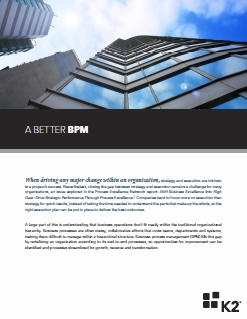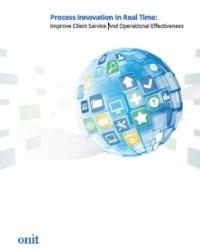Home / Resources
Resources
Discover a Wealth of BPM Knowledge and Expertise at BPMInstitute.org!

Shared Services: A Model for Achieving Government Efficiencies
“I think many [agencies] would greatly benefit from a top-to-bottom efficiency analysis . . . done by people who understand government. The results of such an analysis . . . can provide a menu of choices for . . . officials as they work through the real nitty-gritty issues of efficiency in government.” – John R. Bartle, dean of the College of Public Affairs & Community Service at the University of Nebraska at Omaha

Want to Supercharge Innovation? Map your Customer’s Processes!
Remember when you had to purchase your music via cd’s, records, or cassettes at brick and mortar record stores? Prior to the iPod’s arrival, there was always a delay between the intent to purchase the songs we wanted and the time when we could actually enjoy them. The delay was either the travel time to and from a store to buy the album or the time waiting for an order placed online to arrive from the post office. There definitely wasn’t instant gratification in the process. The purchasing channels were rigid – requiring us to buy in increments of albums instead of choosing the exact songs we wanted. But there wasn’t an outcry from consumers. We learned to live with the shortcomings of the process. But then came revolutionary change.

Making Decisions Operational
My last posting (“Transitioning to a World of Decisions”) began presenting observations of decision modeling, implementation and management as they have moved from theory to practice. These observations have been made from both the Business and IT sides of the Enterprise. Although the sample size is still relatively small, some definite trends are beginning to take shape. While the previous article focused primarily on testing, I also alluded to some difficulties arising from a strict reliance on using decision tables for ALL rules. I have observed this on several projects.

Just in Time Process Modeling
One of the persistent criticisms of BPM is that the process definitions are too rigid to accommodate the realities of modern business. This can deter organizations from properly evaluating how BPM can help them. The reality is that most BPM tools offer a range of options for building highly flexible and adaptable processes. In this article, we will briefly explore some of these.

BPM – How to Make It Stick
How to make BPM stick is one of the most frequently asked questions by participants at BPMInstitute.org. How is it possible to engage everyone in following the re-designed process and how best to assure continuous improvement of the new process are just two of the questions that come up regularly.
While making BPM stick is just as much art as it is science, there are some important guidelines to note around enablers such as transparency, advocacy, alignment and accountability as well as some key pitfalls to avoid. These are outlined below.

What is a Customer-Focused Process?
Historically process improvement efforts centered on improving quality, reducing costs, or increasing throughput. The success of these efforts elevated the process discipline to become a standard approach to improve the operations of companies around the world. But there are other targets of process improvement beyond simply efficiency gains. Arguably the facet of process-based improvement that has been least utilized is its use as a tool for understanding strategy. As companies seek to implement new strategies they often struggle to align their resources to the new direction. A common complaint from leadership teams is that their organization lacks the ability to execute. Here is the next frontier of process improvement – as a tool to strategically recalibrate a company.

A Better BPM
BPM suites add value but are often monolithic systems that take a high level of knowledge and training to implement and use, causing upfront disruption that can adversely affect the business. This also makes these systems slow to make an impact and difficult to use for one-off needs – creating challenges for companies that need quick results.
Organizations need agile platforms that are faster to market and provide deeper value. To this end, business process application suites provide flexible solutions that support your full range of BPM needs, including top-down initiatives, smart process applications, and the need for rapid app development platforms that can be used by IT and business users alike.

Starting and Advancing a BPM Measurement System
Do you know how each process is performing right now in your organization? And if you’ve improved a particular process do you know if you achieved the level of improvement you wanted? It’s necessary to quantify data to be able to answer these two questions and provide objective ways to measure process and level of change.
So if you’re working on a single business process improvement project or many processes across the enterprise, you need a measurement system. But how do you build one that is comprehensive, efficient and effective?
Where do you start? You have to start from where you are, so the Process Maturity Framework can help identify where on the continuum your organization is. The first graphic below shows the five levels of the CMMI Process Maturity Framework, with descriptors at each level.

Business Architecture: Why Businesses Require a Stakeholder Value-Driven Perspective
A recently published article entitled “Business Capability Architecture Is the Tie that Binds All” discussed how to use business capabilities to tie business strategy, enterprise change, and project portfolio prioritization. We concur that strategy, enterprise change, and portfolio management are managed more effectively using business architecture, and agree that capabilities are a component of business architecture. However, we view the article’s notion of “business capability architecture” as being incomplete. We will discuss why this concept is incomplete and how it can be extended through value mapping.

The Four Agreements You Need to Have a Successful Process Mapping Session
The Four Agreements You Need to Have a Successful Process Mapping Session
Process mapping is a group exercise in which teams of subject matter experts (SMEs) gather to determine how work gets done. Step-by-step diagrams are drawn to document the who, what, when and how a business task is performed. Teams utilize process mapping as a way of finding opportunities for improvement, increasing transparency between groups, and understanding the roles of systems in processes.

Product Demonstration Oracle BPM Suite 11g
This workshop will give participants hands-on exposure to Business Process Management with the Oracle BPM Suite and will show how Oracle BPM Suite can be used across each phase of the BPM lifecycle to achieve continuous process improvement.
This workshop will demonstrate process modeling, process improvement, process implementation, process interaction and process monitoring using a government specific use-case of construction/building permit processing across various roles and systems.
Presenter Bios

Process, Outcomes and Metrics
Recently there was a discussion among various BPM experts about process and outcomes, that has me questioning the different ways business process professionals think currently about process improvement. My position in the discussion was that focusing on process and outcome simultaneously was necessary. Further, it was my contention that the statistical process control methodology Deming advocated assumed that customer satisfaction would always increase in parallel with improvements in quality.
General Motors discovered in the 80’s with the leather seats in its Cadillac line of automobiles that increases in quality do not necessarily equate to raised levels of customer satisfaction. This discovery led to conversations about rising customer expectations, especially during the 90’s.

Process Innovation In Real Time
Quality processes are central to the success of any large organization, and all business units should play by the same rules. While this is certainly true, each department is bound to have unique requirements which is why a one-size-fits-all approach to business processes doesn’t work. This white paper uses the example of one department that typically considers itself the exception to business process standardization, the legal department. Readers will learn how solid business processes enabled this department to improve its work involving customer transactions and its effort to make business units more successful.

How Can a Project Manager Add Value to a BPM Project?
Project Manager is a common term in business these days. On the simplest level, a Project Manager can be an individual in charge of a plan that was developed on a ‘cocktail napkin’ or simple spreadsheet. For a more complex project, the Project Manager can be an employee in the Project (or Program) Management Office, be certified in Project Management by passing the rigorous PMI test, create sophisticated work breakdown schedules using software and manage enterprise projects from beginning to end for the organization. The kind of Project Manager I am talking about has responsibilities like the second type above, but may not always work on enterprise projects; instead he might work on medium or large projects as well.

Finding Agile (In Decision Management Tech Implementation)
Even though Decision Management technologies are built upon agile development principles, implementation projects frequently get bogged down in traditional approaches. Let us embark on a journey in the hopes of Finding Agile in those murky waters.
Decision Management Technologies are Center Stage
Most of the new advances in technology are aimed at making the systems more intelligent by having them do more knowledge work. These collection of technologies are the Decision Management technologies – that includes business rules, analytics and optimization. Since decision-making is amongst the most fluid aspects of an organization and the logical place to plug knowledge in, all related technologies are experiencing a surge in demand.

BPM versus OpX
The proliferation of process improvement methods over the past decade has become problematic. The range of process improvement methods now includes BPM, Lean, Six Sigma, Lean Six Sigma, Operational Excellence (OpX), Process Excellence (PEX), Reengineering (BPR) and several older techniques such as the theory of constraints (TOC) which are still in use in some organizations.
As process improvement professionals develop increasing skill in a selected improvement method, they are inclined to think and communicate that their method is better than alternative approaches to process improvement. Executives seeking to improve operational performance are sometimes confused about the similarities and differences between various methods and feel that they “have to choose a side.”

Business Architects and Product Managers
Let me start with a provoking question: Business architects create capability roadmaps and product managers create product roadmaps. What is the difference and which is more valuable for my business? If product managers manage all the products of a company, is there a need for business architects and capability roadmaps?
Some of us, who are practicing business architects and familiar with “Guide to the Business Architecture Body of Knowledge™” (BIZBOK® Guide), may find this question offensive. However, this could be a reasonable question from any senior business leader (particularly unfamiliar with business architecture and product management disciplines).

Governance is Not a Four Letter Word
At a recent client meeting, the Chief Architect arrived a few minutes late, clearly upset. When asked what was bothering him, he muttered “Governance is a four letter word”. I am sure that many readers have shared that sentiment at some time, but it needn’t be that way.
Organizations who have adopted BPM as their platform for IT development have an opportunity to both simplify and improve their IT Governance and Compliance processes. All of the advantages which BPM brings to your core business processes are just as applicable to IT Governance.

Leading Organizational Redesign with Business Architecture
Reorganization of a business is not easy. Following the usual process of organizational design, you work to identify the current organization, note the gaps and describe a process for getting to the new organization. That sounds easy enough in theory, but implementing the reorganization is not nearly as straight forward. Asking stakeholders what the problems are usually only gets you symptoms. Identifying gaps is difficult because if the organization knew there were gaps, they would have fixed them. Then you have those who abhor change who believe their area of the business works fine – it’s everyone else’s fault.
Getting Started

Transitioning to a World of Decisions
As the concepts of decision modeling and management increasingly move from theory to practice, it has been interesting to note how it is perceived and approached by both business and IT. Perhaps not surprisingly, my experience has shown this to be a smoother transition for business. This is something we should expect as it presents a more natural representation of the business for the business. The IT side has certainly had a variety of tools available in numerous platforms to support this approach and the emergence of the Decision Model and Notation (DMN) standard now brings a cohesive view across industries. However, it does seem to present a few challenges to IT in this early stage of evolution.













